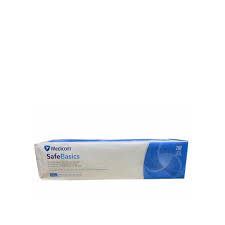Introduction
Sterile surgical gowns are a vital component of personal protective equipment (PPE) used by healthcare professionals during surgical procedures. Designed to create a barrier between the surgical team and the patient, these gowns help prevent the transmission of microorganisms, body fluids, and particulate matter. They play a critical role in maintaining a sterile environment in the operating room and are essential for both patient safety and surgeon protection.
Design and Construction
Surgical gowns are typically made from high-quality, fluid-resistant materials such as spunlace non-woven fabric, SMS (Spunbond-Meltblown-Spunbond), or laminated polypropylene. These materials provide strength, breathability, and protection against fluid penetration. Gowns are designed with full coverage in mind, covering the torso, arms, and knees, and are secured with adjustable neck and waist ties or hook-and-loop fasteners for a secure fit.
The sleeves are long and often feature knitted or elastic cuffs that allow for a snug fit around the wrists and seamless integration with surgical gloves. Reinforced versions of gowns are available for high-fluid procedures, offering extra protection in critical zones such as the chest and forearms.
Sterility and Packaging
Each surgical gown is individually packed and sterilized using methods such as ethylene oxide gas or gamma irradiation. The sterile packaging is clearly labeled with size, sterility status, and expiration date, ensuring safety and compliance with medical standards. Gowns are often available in single or double packaging to facilitate sterile field setup.
They are typically color-coded and labeled by size (Small to XXL) to ensure proper fit for various users, which is important for both safety and comfort during long procedures.
Applications in Surgery
Sterile surgical gowns are used in a wide range of medical procedures, including:
-
General Surgery
-
Orthopedic Surgery
-
Cardiothoracic Procedures
-
Gynecological and Obstetric Surgeries
-
Neurosurgery
These gowns serve as a protective barrier against blood, bodily fluids, and microbial transfer, thus reducing the risk of surgical site infections (SSIs) and contamination.
Key Features and Benefits
-
Sterile and disposable or reusable options
-
Fluid-resistant or fluid-proof materials for high protection
-
Breathable fabrics for comfort during extended use
-
Reinforced areas for high-risk procedures
-
Available in multiple sizes and fits
Some advanced surgical gowns are also equipped with antistatic, flame-retardant, or antimicrobial coatings to enhance protection further.
Conclusion
Sterile surgical gowns are indispensable in operating rooms and critical care environments. By providing a reliable barrier against contamination, they protect both the patient and surgical team, ensuring a safe and sterile surgical field. Their careful design and quality construction contribute to infection control and better surgical outcomes.






Reviews
There are no reviews yet.